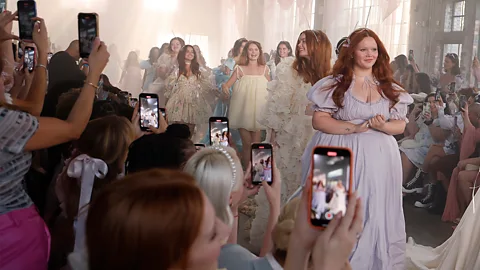By Sarah BregelFeatures correspondent

 Getty Images
Getty ImagesCustomers revolt after Selkie confirms they’re using AI to stay “ahead” of the fashion curve. Are they right to feel betrayed?
Selkie, a viral fashion brand that has pegged itself as “slow fashion” and sustainable, was recently found using generative AI to create its designs. On 17 January, the Chinese company released its 2024 Valentine’s Day collection, called Home Is Where the Heart Is. In an Instagram post, Selkie showed off a few new pieces, but viewers quickly noticed something was off. The collection featured several dresses and sweatshirts with patterns of cats and dogs, but one of the designs featured a puppy that appeared to have a few too many toes.
Commenters blasted the brand for using AI, prompting Selkie to respond by posting their own comment on the emergence of AI in fashion.
“The topic of AI art continues to be a polarizing one that some artists are for and others are against,” a Selkie representative wrote on the post. “As an artist who enjoys technology, and seeing AI already being used by other brands in different ways, it felt important to learn this new medium and how it may or may not work for Selkie as a brand, and herself as an artist,” they continued, referring to Selkie founder Kimberley Gordon’s AI-generated work. ” They also noted on Instagram that the company prides itself on being “ahead of the curve, not behind it”.
Selkie is far from the first fashion brand to make use of generative AI. In 2023, Valentino created AI-generated visuals for its Essential campaign. Prada and Gucci also crafted AI adverts. Levi’s used it to create a series of digital models for its e-commerce site, too; the move was met with backlash for relying on AI-generated images of humans instead of putting models to work (they also said they took the decision to promote “increased diversity”).
Some fashion brands are not just using AI for adverts, but also creating entire collections using it. There is even an AI Fashion Week in New York, dedicated to showcasing the latest designs. Fast-fashion brands, such as H&M, are fully leaning in. Last year, H&M’s Creator Studio even began allowing customers to create their own designs, which are later printed onto clothing using its new generative-AI platform Stable Diffusion. And, according to a 2023 Mckinsey report, the use of generative AI could add around $275bn (£217bn) to the apparel, fashion and luxury sectors’ operating profits.
That revenue is clearly motivating brands, and experts say we shouldn’t worry. Rajiv Narayana, CEO of US-based learning-design company ansrsource, says that “as with any new innovation” the promises of AI tend to be “overstated, and how quickly the changes happen tend to be understated”. He says, “AI is no different with regard to its impact on design,” adding that he doesn’t see it “replacing human creativity”, but we will find better ways to work alongside it.
Hikari Senju, founder and CEO of California-based advertising-personalisation firm Omneky, agrees. He compares AI to the introduction of Photoshop 30 years ago. “I’m sure some people felt let down then when they realised an image was Photoshopped, but it also unlocked a huge wave of creativity from new artists,” he says. He adds companies should “be prepared to be as transparent as possible” about using the technology.
Still, using AI to create actual clothing designs, not just adverts, can feel like a bigger burn for consumers seeking original creations, especially from a brand that prides itself on its ethics when it comes to how items are manufactured. Meghan Fulton, a professional independent designer who has worked for New York City designers including Maddy London, and now owns an upholstery company, understands the controversy and says it’s “a layered question”.
She says while AI has been used for inspiration, using it on the creative side causes friction when brands underestimate their modern-day consumer. “They don’t realise that people care about their purchases and will look into things further.”
Still, Fulton doesn’t find the use of AI in fashion design – even for slow-fashion brands – offensive, either. As long as companies are working with designers who are real people… as opposed to “solely relying on AI”, she says, it’s fair game. Weeding through the comments on Selkie’s maligned Instagram posts, a number of followers agree.

